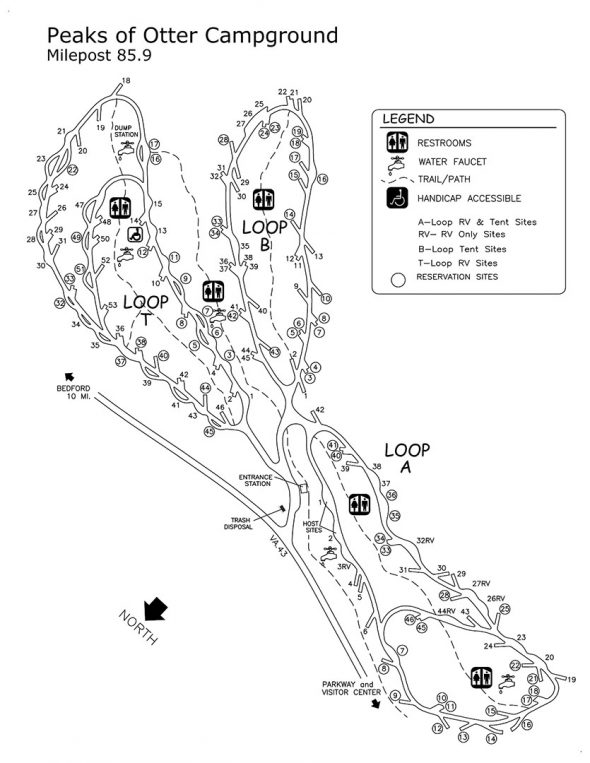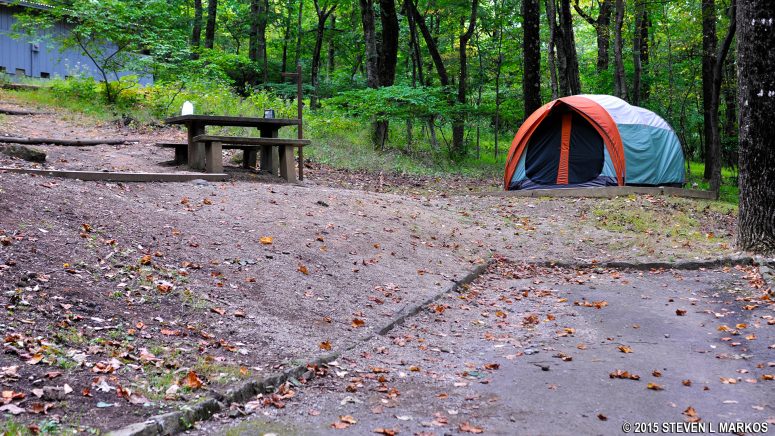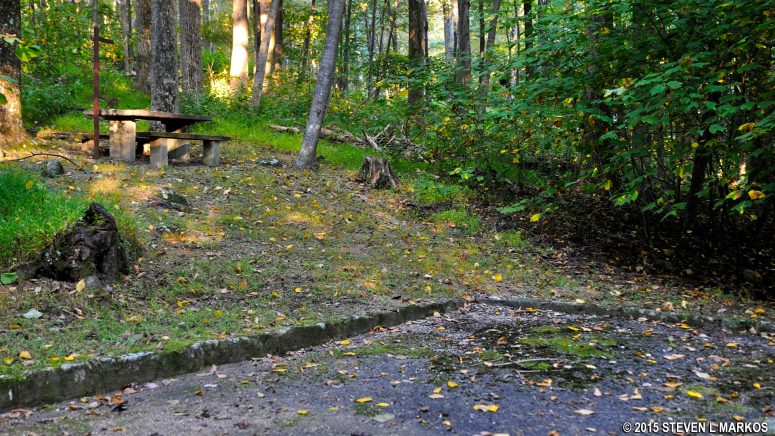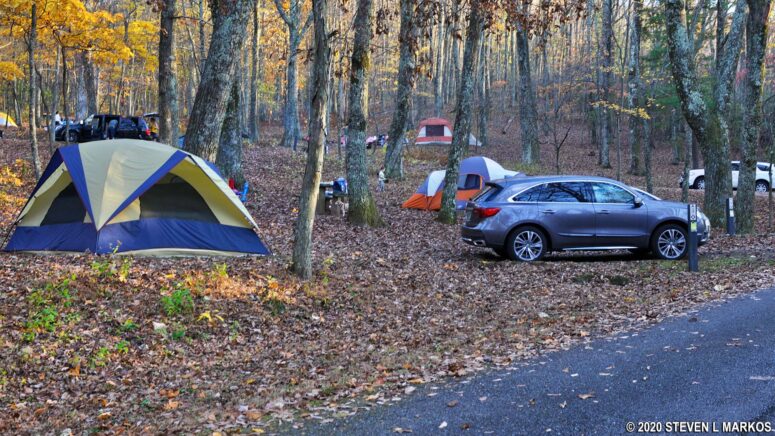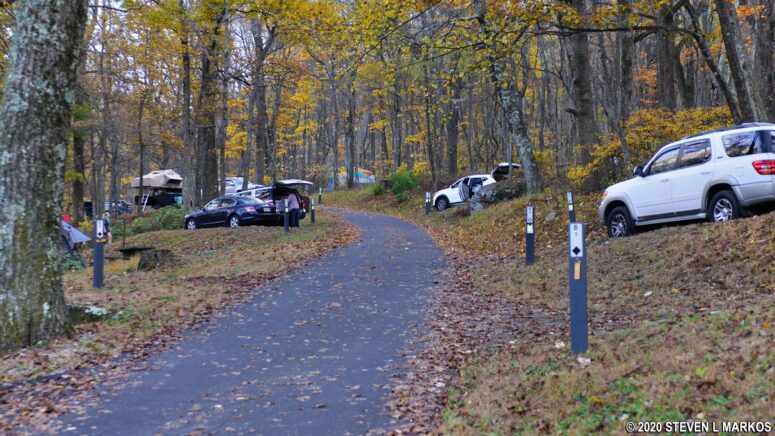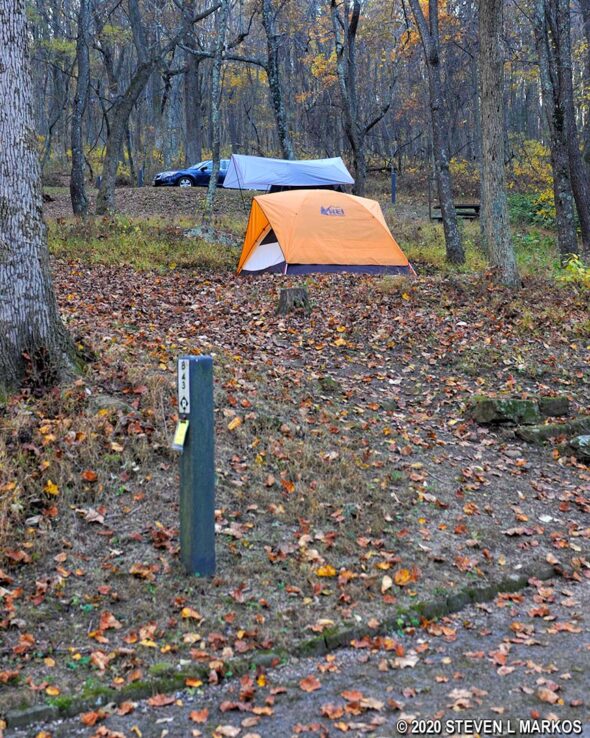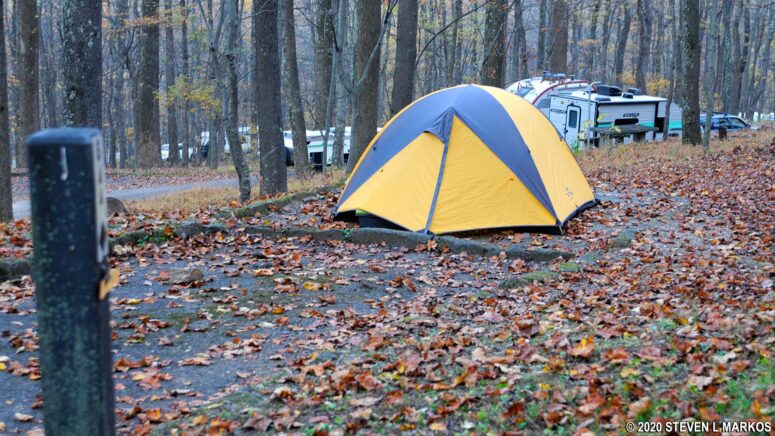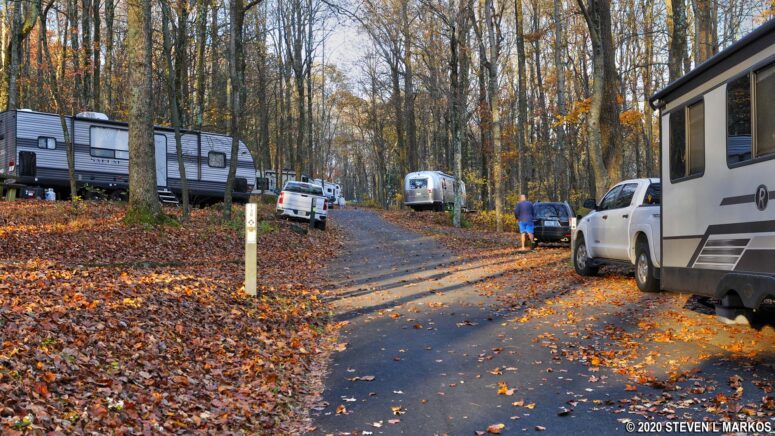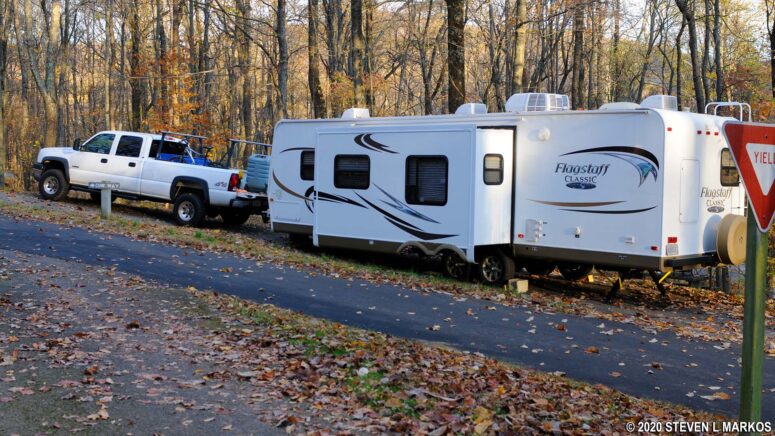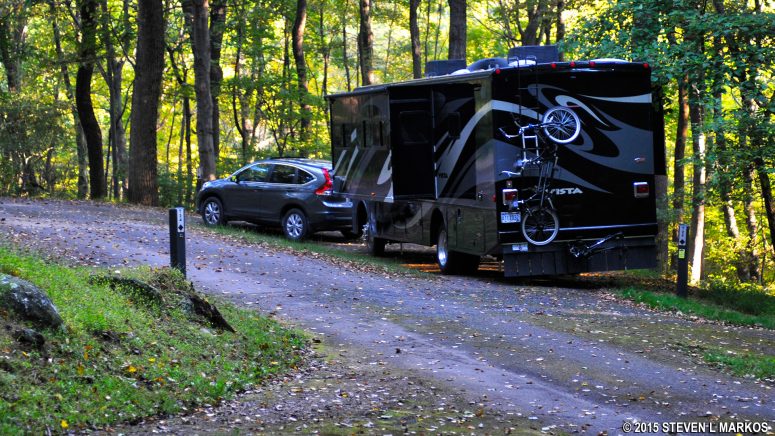CAMPING SEASON
Peaks of Otter Campground is one of eight campgrounds on the Blue Ridge Parkway that is operated by the National Park Service. It is typically open from late May until the end of October, though the opening and closing dates change each year. Be sure to get the latest schedule on the official Operating Hours and Seasons web page for the Blue Ridge Parkway.
TYPE OF CAMPING
Peaks of Otter Campground can accommodate tent campers, RVs, and other self-contained sleeping vehicles. Maximum vehicle lengths for each campsite are given on the reservation website, Recreation.gov. There are no group campsites.
If a campsite has a tent pad, all tents must be pitched on the pad. I’m not sure of the pad size, but they are at least 10′ x 10′. This should allow one large tent or two small tents. If you have more tents than can fit on the pad, you must pay for another campsite. Tent pads are pre-leveled areas of earth that are enclosed in a wood or concrete frame, so regardless of hilly or sloping terrain, you will have a level area on which to pitch your tent.
NUMBER OF SITES
The Peaks of Otter Campground is comprised of three loops and can accommodate both tent campers and RVs of all sizes. The A Loop is mainly for tent campers, though there are four RV sites. B Loop is for tents only. T Loop is for RVs. The difference between RV and tent sites is that RV sites have larger back-in or pull-through parking spaces, and they don’t have tent pads as do tent sites. Overall there are 85 tent sites and 52 RV sites for a total of 137 campsites. Each site can accommodate up to six people. There is one handicap site in the T-Loop.
The Peaks of Otter Campground is built on the side of a mountain, so rarely is the parking space on the same level as the tent area and picnic table. You must carry your gear either up- or downhill from where you park, and some hills are rather steep. Not that there’s much you can do about it, and it’s certainly not the end of the world, but it does somewhat suck. I dropped a canister of propane and had to chase it down the hill all the way to the street. Furthermore, while most parking spaces are right next to the camping area, a few are up to 50 yards away. These may appeal to those who want to be back in the woods and away from the street.
If you show up without a reservation, you can drive around and try to get a level site, but when making reservations in advance, you are really just picking blindly. Recreation.gov does have photos of the sites, but they may not show all angles.
A LOOP
A Loop is a large oval built on the side of a mountain, so one half of the loop is at the top of a ridge and the other half is at the bottom. Campsites are situated on the slopes, though most tent sites either have a natural level area for a tent or a tent pad. In nearly all cases, tent campers must carry their equipment either uphill or downhill from the parking space. The few exceptions are campsites A17, A18, A28, and A43.
Overall there are 44 campsites, 24 of which can be reserved in advance. Most all of these are tents-only sites, but there are four that allow small RVs or other self-contained sleeping vehicles. Driveways are mainly back-in, but there are a few pull-through driveways, including all four of the RV sites. All driveways are deep enough to fit at least a single vehicle. Some may fit two cars end to end, but if you can’t fit your vehicles in the parking space, you will have to park at another location. All vehicles must be parked on the pavement.
Campsites have a picnic table, a grill / fire ring, and a lantern post. Some, but not all, tent sites have a tent pad.
B LOOP
B Loop is just like A Loop: a large oval built on the side of a mountain. Overall, there are 45 campsites, 19 of which can be reserved in advance. All sites are for tent campers only. As with the A Loop sites, there is only room for the parking of one vehicle per site in most cases.
Campsites have a picnic table, a grill / fire ring, and a lantern post. Despite being a tents-only section, not all sites have tent pads.
I didn’t walk the entire B Loop, but I did notice that Site B44 is about as level as you’ll find at Peaks of Otter Campground.
T LOOP
T Loop has 48 campsites, 19 of which can be reserved in advance. All are for RVs and other self-contained sleeping vehicles and trailers. Driveway lengths range from 18 to 80 feet and are a mixture of back-in and pull-through. Some of the back-in driveways are double wide, so you can unhook your trailer and park your truck next to it.
The road through T Loop is hilly, as are many of the driveways, so be prepared to do some serious leveling of your RV. If a level site (or somewhat level) is important to you, avoid T7, T13, T18, T21 through T23, and T33 through T46 (with the exception of T41).
Each campsite has a picnic table and a grill / fire ring.
Campgrounds along the Blue Ridge Parkway are not set up for long term camping, so those with large RVs most likely will not be able to put up awnings and wood decks, as there is very little space on the sides of the parking areas. There may be a small yard where you can set up a table or sitting area. Also, as is the case with the tent sites, the picnic table and campfire area is rarely on the same level as where you park.
AMENITIES
Each loop has at least one restroom building with modern toilets and sinks, but no showers or hot water. No sites have electricity or water hook-ups. There is a dump station for RVs in the T Loop. Keep in mind that many of the National Park Service campground restrooms along the Blue Ridge Parkway do not have paper towels or a hand dryer, and the lighting is often very poor. Lights tend to be over the sink area, but not over the toilet stalls. Bring some sort of lantern with you at night if you plan to use one of the toilets. A flashlight will not provide the proper illumination.
Peaks of Otter Campground also has bear boxes to protect your food from everyone’s favorite campground intruder, but not one per site. Instead, they are randomly scattered throughout the campground. This may be fine if you are there when the campground is nearly empty, but at busy times I guess people just have to fight over who is going to secure their food in the box and who is going to have their car ripped into by a hungry bear. In reality, bears in the campgrounds are rare. Most have learned by now that they are not wanted and that food is usually inaccessible, so I wouldn’t lose any sleep over your food being in your car and not in the bear box.
Firewood and other camping supplies are sold at the Sharp Top Store, which you pass on the way to the campground.
There are a number of hiking trails that depart from the campground. For complete information see the Peaks of Otter Hiking Trails web page.
RESERVATIONS
Select campsites at Peaks of Otter Campground can be reserved up to six months in advance online at Recreation.gov or by calling (877) 444-6777. The rest are taken on a first come, first served basis. Current fees are listed on Recreation.gov. When making reservations you will be given information about the size of the parking areas, so choose appropriately if you are in an RV or trailer. Holders of the Interagency Senior, Access, Golden Age, or Golden Access passes are entitled to a 50% discount on campground fees.
For those arriving at the campground without a reservation, some sites are available on a first come, first served basis, and sites that can be reserved but are not taken are available for that night only. To tell the two types of sites apart, look on the campsite post for a diamond. Solid diamonds are first come, first served sites, and diamonds with an R on them designate sites available for reservation.
When you arrive, drive around and pick out a site. Unoccupied first come, first served sites are yours for the taking for up to 30 days. If there are none left, you can get an open reservable site for one night only. However, don’t assume that just because it is 10 PM and nobody is at a reservable site that it hasn’t been reserved because the person may show up at midnight. Rangers put yellow tags on the posts of sites that have been reserved, so look for R-Diamond posts with no yellow tag. If the campground office is open, you might want to double check before setting up at a reservable site.
Once you have a site, return to the camp office and self-register. You can pay with cash, check, or credit card, though regardless of whether there is a Ranger or camp host on duty, you do not make payment to them. Instead, get a self-registration envelope, provide the requested information (pen or pencil required), and then place cash or check into the envelope, or if paying with a credit card, write the card information on the envelope. When done, tear off your receipt (which you attach to the camp post) and drop the payment envelope into the secure payment box.
If you have a reservation and arrive after hours and there is no tag on your site post, you must get one in the morning at the campground office.
CAMPGROUND RULES
- Camping is limited to a maximum of 30 consecutive days in any one campground and/or 30 days total per calendar year across all Parkway facilities.
- A maximum of 6 people may occupy a site.
- Checkout Time is 12:00 PM.
- Camping is permitted only at designated sites. Sites are for use by a single family or parties not exceeding six people.
- Hammocks may be used within established campsites. An established campsite is defined as within 50 feet of the existing grill/fire pit. They must be at least 20 feet from any public use areas such as trails, water spigots, restrooms, or other facilities. Hammocks may not be connected or tied to any facility. If tied to a tree, the tree must be at least 4 inches in diameter, and anchor ropes/webbing must be ½ inch or greater in width. Padding must be used if less than ½ inch in width. Trimming of trees and underbrush is prohibited.
- Campground speed limit is 15 mph. Vehicles are to be parked on the pavement of an assigned site or in designated parking areas. No more than two vehicles may be parked in each site (i.e., trailer and car, two cars, two motorcycles).
- All food, coolers, equipment used to cook or store food, and anything that may smell like food (such as toothpaste) must be stored in a closed vehicle or a camping unit made of solid, non-pliable material. Food may also be stored in food lockers provided in some campgrounds.
- Only charcoal can be used in any grill provided. Gas grills and stoves are allowed. Extinguish all fires before leaving the campground or picnic area. Do not leave any fire unattended. Only heat-treated firewood that is bundled and certified by the United States Department of Agriculture (USDA) or a state agency may be brought onto the Parkway.
- Wood gathering for use in park campgrounds is limited to dead material on the ground lying no more than 100 yards from the camp or picnic site.
- Respect quiet hours between 10:00 PM to 6:00 AM. Use of generators is prohibited between the hours of 9:00 PM and 8:00 AM. Please keep in mind that continuous, loud generator or audio equipment noise, at any time of the day, disturbs other campers.
- Do not drive nails into trees or strip bark, leaves, or branches from trees or shrubs. Use the lantern posts provided at each site. Do not hang lanterns from trees or loop them over branches or vegetation; these practices always damage and sometimes kill trees and vegetation.
- All dogs, cats, and other pets must be on a leash no longer than six feet or under physical restraint at all times. Do not leave pets unattended in the campground or your car. Please prevent excessive barking and properly dispose of pet waste.
- The use of skateboards, roller skates, and other coasting devices is not permitted in the park or campground. Bicycles are permitted on roads only. NC law requires persons under 16 years of age to wear an approved bicycle helmet when operating a bicycle. In Virginia, bicycle helmet regulations vary by county.
Back to the Top | Peaks of Otter Recreation Area | Campgrounds
With a few exceptions, use of any photograph on the National Park Planner website requires a paid Royalty Free Editorial Use License or Commercial Use License. See the Photo Usage page for details.
Last updated on November 30, 2023

